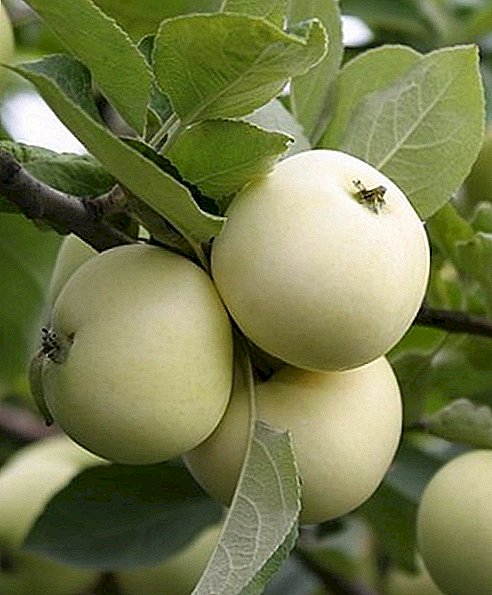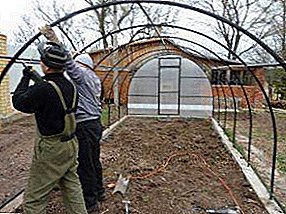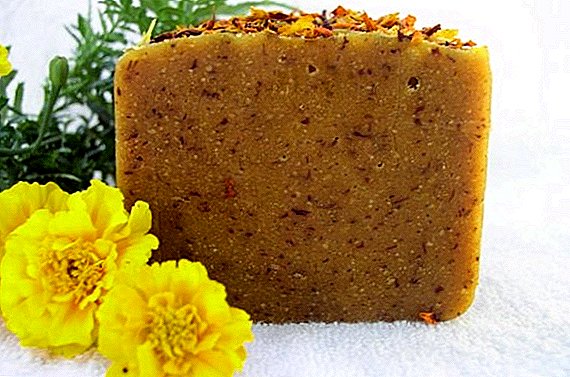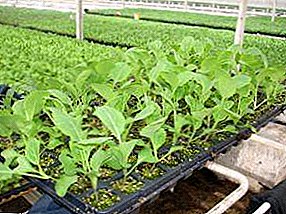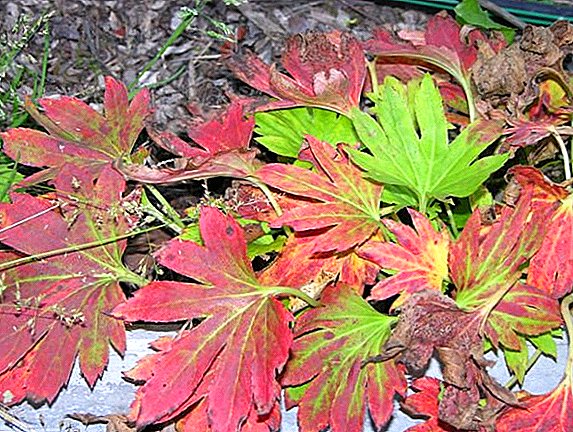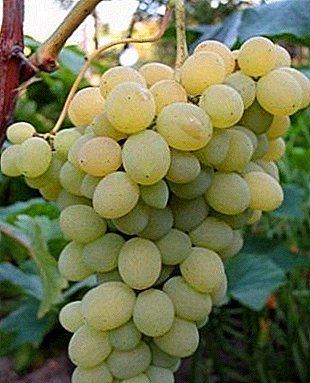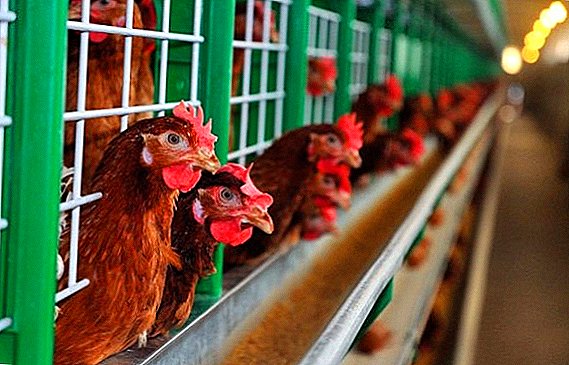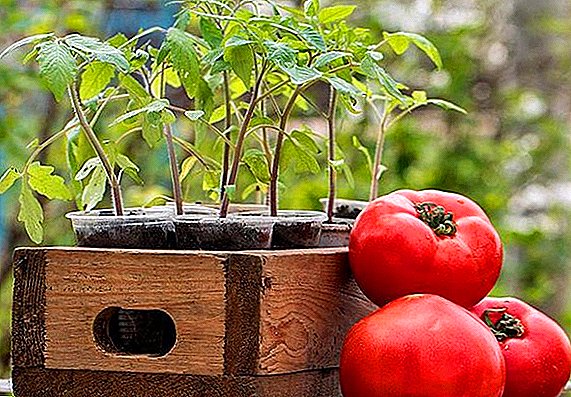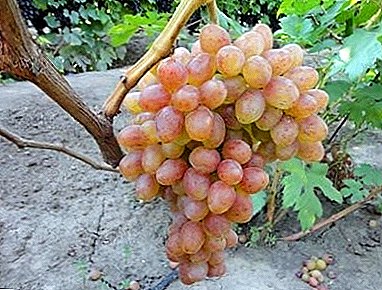
Grapes, as a garden culture, has no rivals, we observe it on the canvases of great masters, ancient frescoes, in the refined decoration of palace interiors and on the carving of gravestones, so beautifully it looks.
Fresh grapes in all its variety of color, shape, taste, won a legitimate royal place on our table. And grape wines are a separate and long history.
But that's not all, because the grapes are also dried, thus obtaining raisins that are stored for a long time and are suitable for use in a variety of dishes. For its preparation are well suited grapes without stones - raisin.
Among the most popular are the Kishmish Century, Attica and Kishmish Jupiter.
Grapes "Kishmish Nakhodka": description of the variety and photos
Kishmish Nakhodka grape variety - very early table grape without pits. The berry is quite large, mass up to 8 grams, oval-shaped, pink in color, sweet, the flesh is dense and has no vestigial inclusions, there is no marked tendency to cracking.
Muscat Bely, Julian and Gordey are also distinguished by very early ripening periods.
The skin is tender. Pink berries are collected in conical clusters of mass from 700 grams to 1500 grams. Productivity is good - 6 kg. from the bush. Already in early August, you can shoot the first brush.
The bush has a great strength of growth, shoots ripen early, have good rooting. Flower bisexual.
Grade Kishmish Nakhodka cold-resistant, cold up to 23 degrees he is not afraid. Disease resistance is also high.
Super Extra, Beauty of the North, Pink Flamingo and Alex also show cold resistance.
Photo grapes "Kishmish find":


Breeding history
Kishmish Nakhodka grape variety obtained by amateur breeder V.N. Krainov.
His hand also belong to Blagovest, Ataman and Gourmet.
Landing
You can plant grapes in autumn, in October, and in spring, in April.
The planting material must surely be the carrier of the desired variety, it is better to purchase it from a well-known producer or a familiar grower.
A sapling will transfer the planting easier if it is grown in a container, if the root system is open and could not be harmed, stimulate its rooting and growth by the preparation Corneuritis.
By choosing a place under the vineyard, you need to be careful, and give preference to solar areas oriented to the south or south-west of the world, suitable walls and fences with the same orientation.
A gardener planting grapes should feel like a landscape designer and choose a place where the plant will surprise its beautiful beauty and reward them with rich crops.
 Grapes grow well and bear fruit on light fertile soils, but if they are absent, it is not difficult to improve them by adding humus, organic and mineral fertilizers and broken red bricks.
Grapes grow well and bear fruit on light fertile soils, but if they are absent, it is not difficult to improve them by adding humus, organic and mineral fertilizers and broken red bricks.
Groundwater should not be located closer than one and a half meters, otherwise the use of drainage is necessary.
Planting pits are being dug for planting in the chosen place. meter per meter with distance one and a half or two meters between plants and two meters - between rows.
The bottom of the pit we fall asleep with broken red brick and chopped brushwood, we add cow manure and a bit of complex mineral fertilizer to the soil, and broken red brick will not hurt. Sapling abundantly watering, we mulch the soil, the event is not mandatory, but useful.
Care
Care of seedlings is reduced to timely weeding and watering. Watering should be carried out as the soil dries, you can not use any kind of water sprayers, this contributes to the development of diseases. Weeding does not allow weeds to weaken your seedlings.
The force of weed growth is much more active than that of still weak young plants.
Top dressing
Grapes grow quickly and for its normal development it is necessary use fertilizers. Fertilizers are divided into two types: organic and mineral.
Organic fertilizer - rotted cow dung is applied during planting, and then after three years.
Mineral fertilizers are applied several times per season, and preferably dissolved in water. Well proven foliar top dressing. The microelements included in the preparations contribute to the full development of the plant, strengthening its resistance to disease and weather conditions.
Foliar dressing is carried out in three stages. The first spraying is necessary before flowering, the second - when the ovary is the size of a pea, the third - through 12-15 days after the second. Preparations for foliar feeding developed a lot: Ecolist, Kristalon, Basfoliar, Admin.
Protection against diseases and pests
 Grapes Kishmish Hope is resistant to diseases, it is a great advantage of the variety, but you should not refuse from the preventive treatment of mildew, oidium and rot.
Grapes Kishmish Hope is resistant to diseases, it is a great advantage of the variety, but you should not refuse from the preventive treatment of mildew, oidium and rot.
To protect the grapes from diseases often used drug local type of action - Bordeaux liquid. The tool does not penetrate the body of the plant.
Along with drugs of local action, contact-type drugs are widely used. They penetrate the plant body and act on the focus of the disease, wherever it is located. These are drugs: Kvadris 250, Acrobat, Topaz.
In the event that you noticed pests, you can use any insecticide, strictly following the instructions for use.
It is much more difficult to fight wasps, they gnaw through the bags. Wasps love the smell of fermented fruit, and the winegrowers prepare poisonous baits from compotes, jams and even beer.
In the spring, wasp larvae are poisoned with minced meat with insecticide. Protects the ripening fruits of grapes mustard. It does not affect the quality of the berry, it is well washed off. The working solution is prepared from 200 gr. dry mustard powder on 10 l. water.
The grape variety Kishmish Nakhodka, due to its cold resistance, has received widespread territorial distribution, and its wonderful taste has made it a favorite of winegrowers.
Among the particularly tasty varieties can also be distinguished Galben Nou, Black Raven and Victoria.



